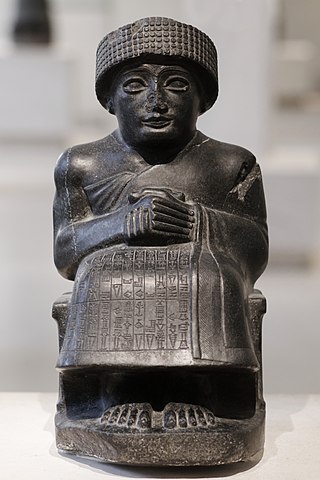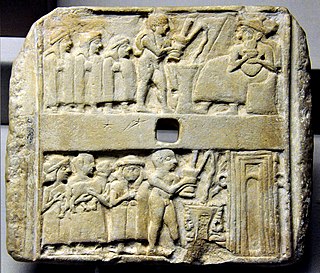Sumeria, or Sumer, is the region of city-states in ancient Mesopotamia.

Sumer is the earliest known civilization, located in the historical region of southern Mesopotamia, emerging during the Chalcolithic and early Bronze Ages between the sixth and fifth millennium BC. Like nearby Elam, it is one of the cradles of civilization, along with Egypt, the Indus Valley, the Erligang culture of the Yellow River valley, Caral-Supe, and Mesoamerica. Living along the valleys of the Tigris and Euphrates rivers, Sumerian farmers grew an abundance of grain and other crops, a surplus which enabled them to form urban settlements. The world's earliest known texts come from the Sumerian cities of Uruk and Jemdet Nasr, and date to between c. 3350 – c. 2500 BC, following a period of proto-writing c. 4000 – c. 2500 BC.

The Sumerian King List or Chronicle of the One Monarchy is an ancient literary composition written in Sumerian that was likely created and redacted to legitimize the claims to power of various city-states and kingdoms in southern Mesopotamia during the late third and early second millennium BC. It does so by repetitively listing Sumerian cities, the kings that ruled there, and the lengths of their reigns. Especially in the early part of the list, these reigns often span thousands of years. In the oldest known version, dated to the Ur III period but probably based on Akkadian source material, the SKL reflected a more linear transition of power from Kish, the first city to receive kingship, to Akkad. In later versions from the Old Babylonian period, the list consisted of a large number of cities between which kingship was transferred, reflecting a more cyclical view of how kingship came to a city, only to be inevitably replaced by the next. In its best-known and best-preserved version, as recorded on the Weld-Blundell Prism, the SKL begins with a number of antediluvian kings, who ruled before a flood swept over the land, after which kingship went to Kish. It ends with a dynasty from Isin, which is well-known from other contemporary sources.

The history of Sumer spans the 5th to 3rd millennia BCE in southern Mesopotamia, and is taken to include the prehistoric Ubaid and Uruk periods. Sumer was the region's earliest known civilization and ended with the downfall of the Third Dynasty of Ur around 2004 BCE. It was followed by a transitional period of Amorite states before the rise of Babylonia in the 18th century BCE.
Uruk, today known as Warka, was a city in the ancient Near East situated east of the present bed of the Euphrates River on the dried-up ancient channel of the Euphrates. The site lies 93 kilometers northwest of ancient Ur, 108 kilometers southeast of ancient Nippur, and 24 kilometers southeast of ancient Larsa. It is 30 km (19 mi) east of modern Samawah, Al-Muthannā, Iraq.

Ziusudra of Shuruppak is listed in the WB-62 Sumerian King List recension as the last king of Sumer prior to the Great Flood. He is subsequently recorded as the hero of the Eridu Genesis and appears in the writings of Berossus as Xisuthros.

Magan was an ancient region in what is now modern day Oman and United Arab Emirates. It was referred to in Sumerian cuneiform texts of around 2300 BCE and existed until 550 BCE as a source of copper and diorite for Mesopotamia. As discussed by The Archeology Fund founded by Juris Zarins, "The Sumerian cities of southern Mesopotamia were closely linked to the Gulf. Archaeologists and historians have linked sites in Saudi Arabia, Bahrain, and Qatar to the Sumerian geographical term of Dilmun. Oman, was most likely the Sumerian Magan".

Samsu-iluna was the seventh king of the founding Amorite dynasty of Babylon. His reign is estimated from 1749 BC to 1712 BC, or from 1686 to 1648 BC. He was the son and successor of Hammurabi by an unknown mother. His reign was marked by the violent uprisings of areas conquered by his father and the abandonment of several important cities.

Lugal-Zage-Si of Umma was the last Sumerian king before the conquest of Sumer by Sargon of Akkad and the rise of the Akkadian Empire, and was considered as the only king of the third dynasty of Uruk, according to the Sumerian King List. Initially, as king of Umma, he led the final victory of Umma in the generation-long conflict with the city-state Lagash for the fertile plain of Gu-Edin. Following up on this success, he then united Sumer briefly as a single kingdom.

Lipit-Ishtar was the 5th king of the First Dynasty of Isin, according to the Sumerian King List (SKL). Also according to the SKL: he was the successor of Išme-Dagān. Ur-Ninurta then succeeded Lipit-Ištar. Some documents and royal inscriptions from his time have survived, however, Lipit-Ištar is mostly known due to the Sumerian language hymns that were written in his honor, as well as a legal code written in his name —which were used for school instruction for hundreds of years after Lipit-Ištar's death. The annals of Lipit-Ištar's reign recorded that he also repulsed the Amorites.

Samuel Noah Kramer was one of the world's leading Assyriologists, an expert in Sumerian history and Sumerian language. After high school, he attended Temple University, before Dropsie University and the University of Pennsylvania, all in Philadelphia.

Utu-hengal, also written Utu-heg̃al, Utu-heĝal, and sometimes transcribed as Utu-hegal, Utu-hejal, Utu-Khengal, was one of the first native kings of Sumer after two hundred years of Akkadian and Gutian rule, and was at the origin of the foundation of the Third Dynasty of Ur by his son-in-law Ur-Nammu. He was officially "King of Uruk" in his inscriptions, and is therefore considered as the founder, and only member, of the "Fifth dynasty of Uruk".

The Early Dynastic period is an archaeological culture in Mesopotamia that is generally dated to c. 2900 – c. 2350 BC and was preceded by the Uruk and Jemdet Nasr periods. It saw the development of writing and the formation of the first cities and states. The ED itself was characterized by the existence of multiple city-states: small states with a relatively simple structure that developed and solidified over time. This development ultimately led to the unification of much of Mesopotamia under the rule of Sargon, the first monarch of the Akkadian Empire. Despite this political fragmentation, the ED city-states shared a relatively homogeneous material culture. Sumerian cities such as Uruk, Ur, Lagash, Umma, and Nippur located in Lower Mesopotamia were very powerful and influential. To the north and west stretched states centered on cities such as Kish, Mari, Nagar, and Ebla.

Sumerian literature constitutes the earliest known corpus of recorded literature, including the religious writings and other traditional stories maintained by the Sumerian civilization and largely preserved by the later Akkadian and Babylonian empires. These records were written in the Sumerian language in the 3rd and 2nd millennia BC during the Middle Bronze Age.

Sumerian religion was the religion practiced by the people of Sumer, the first literate civilization found in recorded history and based in ancient Mesopotamia, and what is modern day Iraq. The Sumerians widely regarded their divinities as responsible for all matters pertaining to the natural and social orders of their society.
Sumer was the first urban civilization in the historical region of southern Mesopotamia












